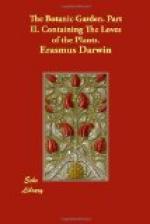Class I. One male, Monandria; includes the plants which possess but One Stamen in each flower.
II. Two males, Diandria. Two Stamens.
III. Three males, Triandria. Three Stamens.
IV. Four males, Tetrandria. Four Stamens.
V. Five males, Pentandria. Five Stamens.
VI. Six males, Hexandria. Six Stamens.
VII. Seven males, Heptandria. Seven Stamens.
VIII. Eight males, Octandria. Eight Stamens.
IX. Nine males, Enneandria. Nine Stamens.
X. Ten males, Decandria. Ten Stamens.
XI. Twelve males, Dodecandria. Twelve Stamens.
The next two Classes are distinguished not only by the number of equal and disunited males, as in the above eleven Classes, but require an additional circumstance to be attended to, viz. whether the males or stamens be situated on the calyx, or not.
XII. TWENTY MALES, Icosandria. Twenty Stamens inserted on the calyx or flower-cup; as is well seen in the last Figure of No. xii. in the annexed Plate.
XIII. MANY MALES, Polyandria. From 20 to 100 Stamens, which do not adhere to the calyx; as is well seen in the first Figure of No. xiii. in the annexed Plate.
In the next two Classes, not only the number of stamens are to be observed, but the reciprocal proportions in respect to height.
XIV. TWO POWERS, Didynamia. Four Stamens, of which two are lower than the other two; as is seen in the two first Figures of No. xiv.
XV. FOUR POWERS, Tetradynamia. Six Stamens; of which four are taller, and the two lower ones opposite to each other; as is seen in the third Figure of the upper row in No. 15.
The five subsequent Classes are distinguished not by the number of the males, or stamens, but by their union or adhesion, either by their anthers, or filaments, or to the female or pistil.
XVI. ONE BROTHERHOOD, Monadelphia. Many Stamens united by their filaments into one company; as in the second Figure below of No. xvi.
XVII. TWO BROTHERHOODS, Diadelphia. Many Stamens united by their filaments into two Companies; as in the uppermost Fig. No. xvii.
XVIII. MANY BROTHERHOODS, Polyadelphia. Many Stamens united by their filaments into three or more companies, as in No. xviii.
XIX. CONFEDERATE MALES, Syngenesia. Many Stamens united by their anthers; as in first and second Figures, No. xix.
XX. FEMININE MALES, Gynandria. Many Stamens attached to the pistil.
The next three Classes consist of plants, whose flowers contain but one of the sexes; or if some of them contain both sexes, there are other flowers accompanying them of but one sex.




